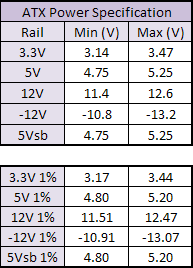Testing & Results
The PSU was loaded with a specific current which applies a certain amount of power to an applicable rail. The simple equation, Current (Amps) x Voltage (Volts) = Power (Watts) was used to determine this.The official ATX specification is shown below, and if a PSU falls outside this range, no matter how quiet it sounds or what kind of special cable management it has, it fails in what it's primarily designed to do. A poor power supply can affect total system stability and reliability causing no end of headaches.
The 80 plus programme is an independent certification that PSU manufacturers are now going after in order to fully ratify their product as capable of 80+ percent efficiency at 20, 50 and 100 percent loads and PFC of over 90 percent. It's an electric utility-funded incentive programme to force companies to make more efficient products as wattages spiral ever upwards, in order to save the consumer as much money as possible.
Traditionally people have looked for the Energy Star rating, of which 90 percent of
 computers on the market currently adhere to, but this was last revised in July 2000, which is somewhere in the region of a millennia in computer years. An updated Energy Star specification (version 4.0) has gone into effect from July 20th, 2007 and includes the 80 Plus programme's requirements.
computers on the market currently adhere to, but this was last revised in July 2000, which is somewhere in the region of a millennia in computer years. An updated Energy Star specification (version 4.0) has gone into effect from July 20th, 2007 and includes the 80 Plus programme's requirements.Unfortunately the Nesteq Nova isn't featured on the 80 Plus site, so it hasn't already been pre certified before testing.
Throughout testing the unit was literally silent without the fan running and there was no buzzing or coil whine either. When the fan finally kicked in when we really loaded the unit but we still had to put our ear right to it to check if it was running or not.
The Nesteq Nova 600W remained nominally cool to touch during our entire testing session, even after a period of sustained 100 percent load. There was very little air coming out the back of the unit when the fan was running and the highest temperature we recorded was 38ºC.

Even though it's quiet, and starts off well, both 3.3V and 5V rails drop well below the minimum ATX specification. The 5V standby also follows suit, but is far less important. The efficiency isn't up to much either where ideally we'd be looking at over 80 percent, but unfortunately the unit doesn't manage to reach that figure across the board. Even the PFC is slightly lower than what we're used to looking at too. It's a real shame because it seemed so promising given the very cool, extremely quiet nature of the device.

MSI MPG Velox 100R Chassis Review
October 14 2021 | 15:04









Want to comment? Please log in.